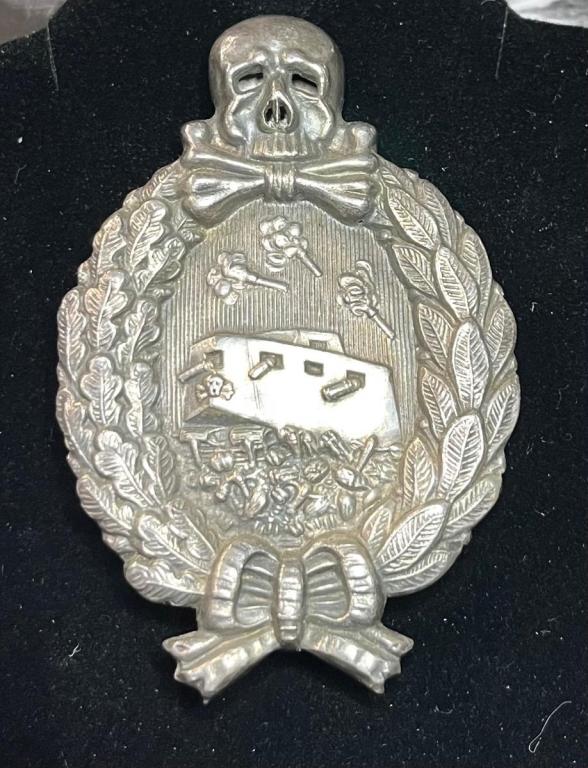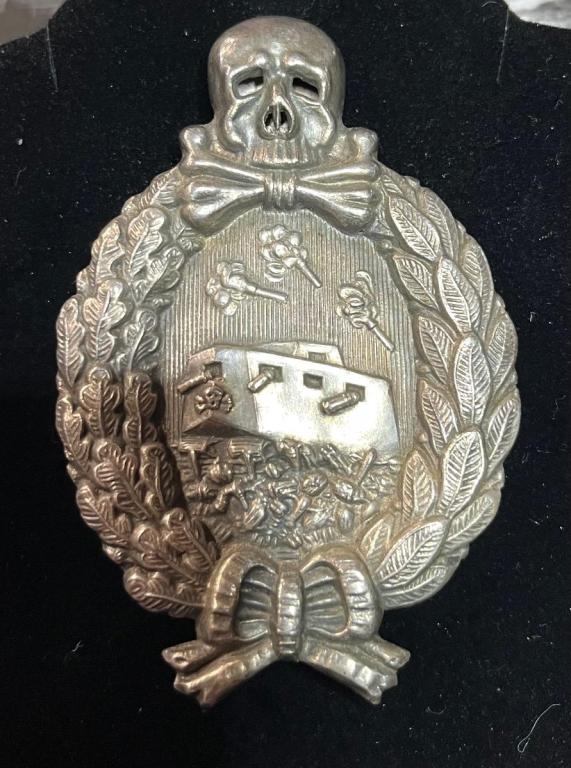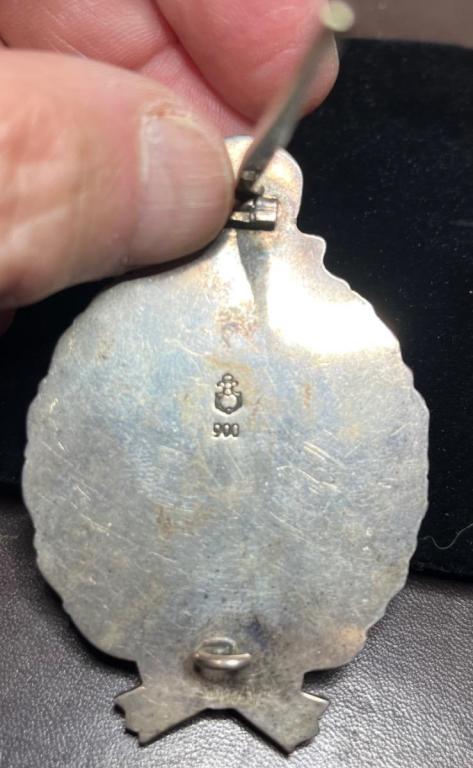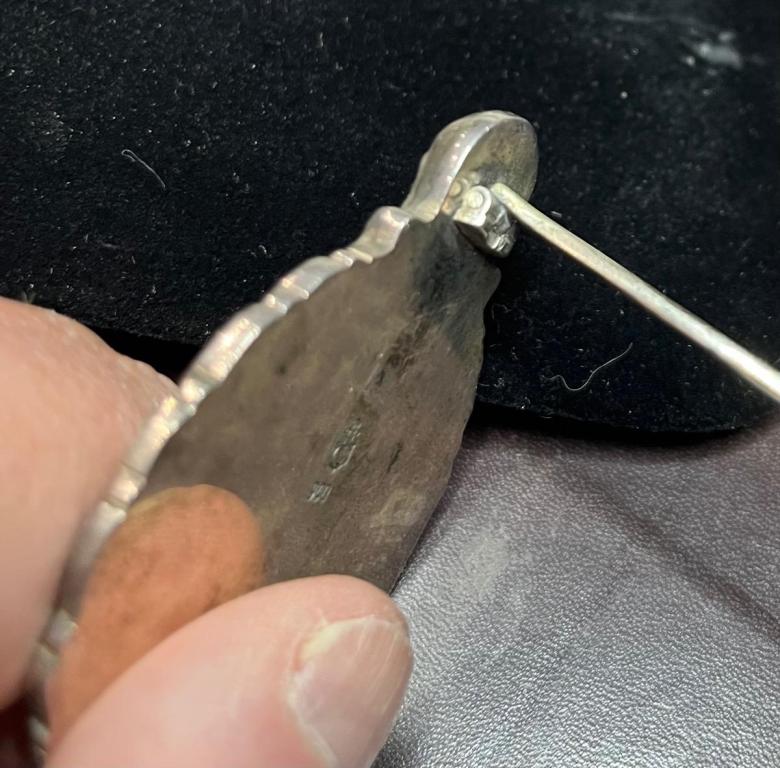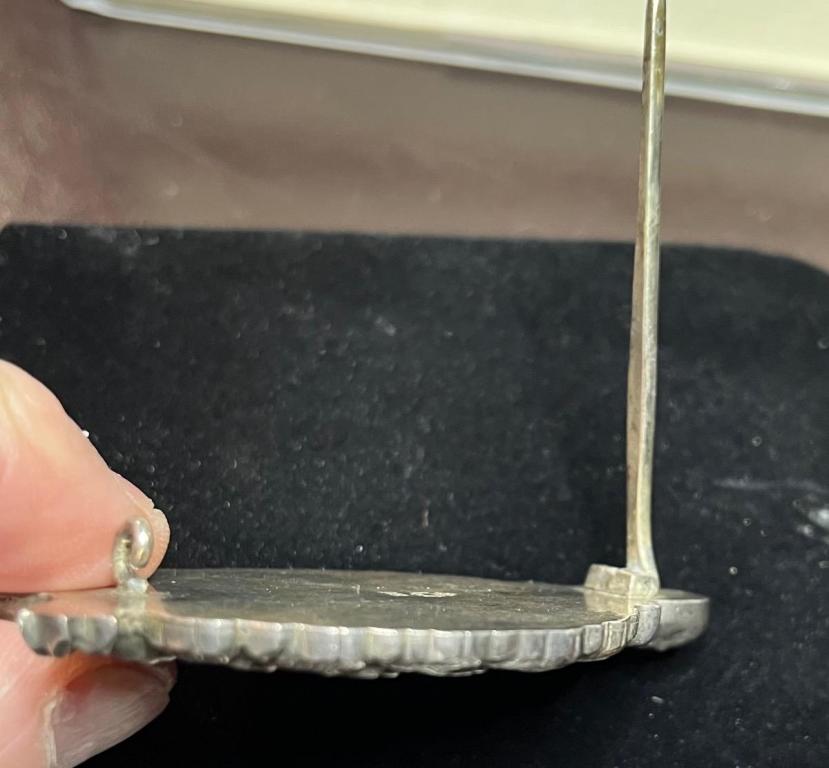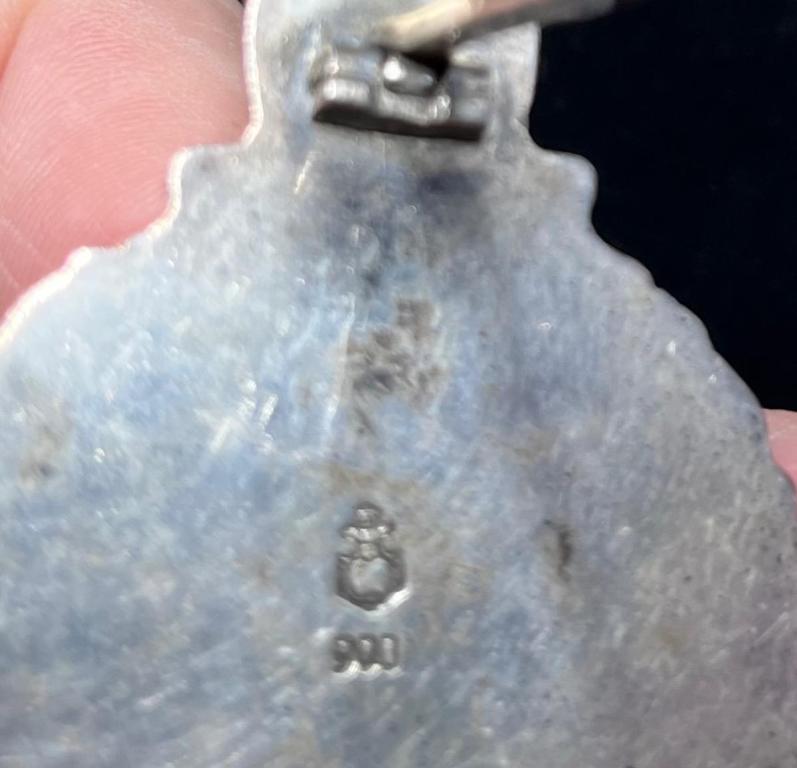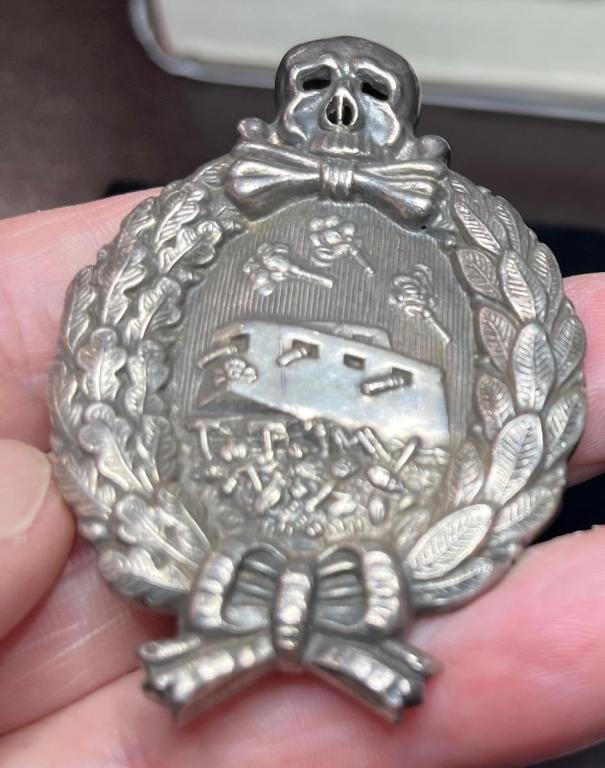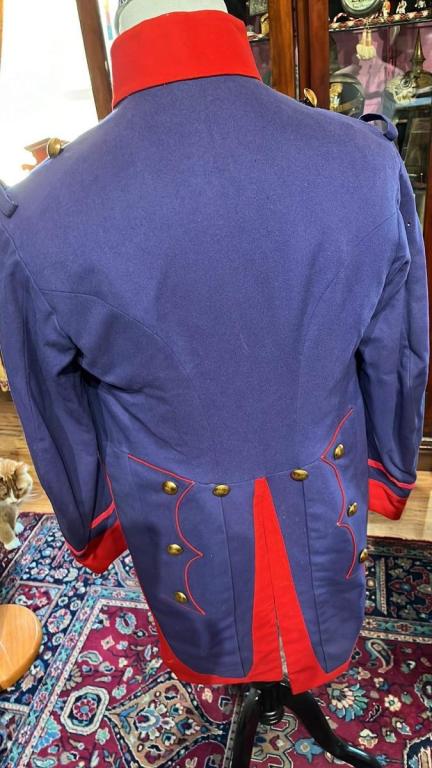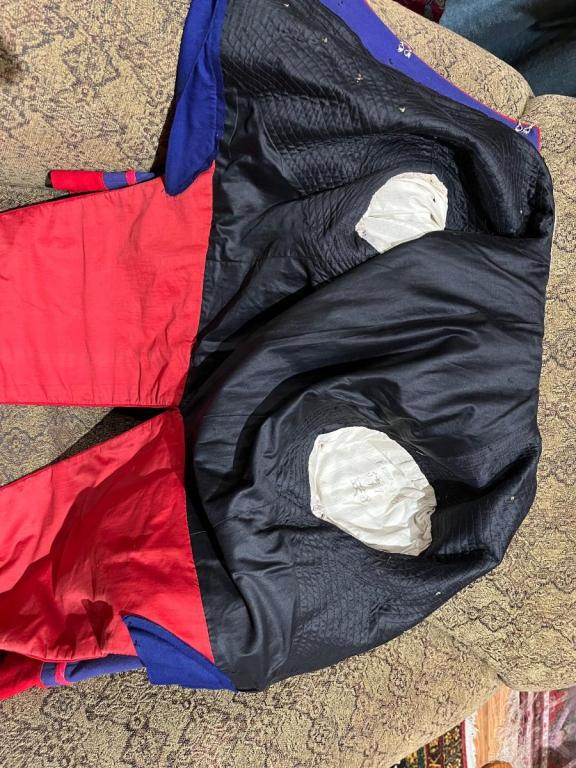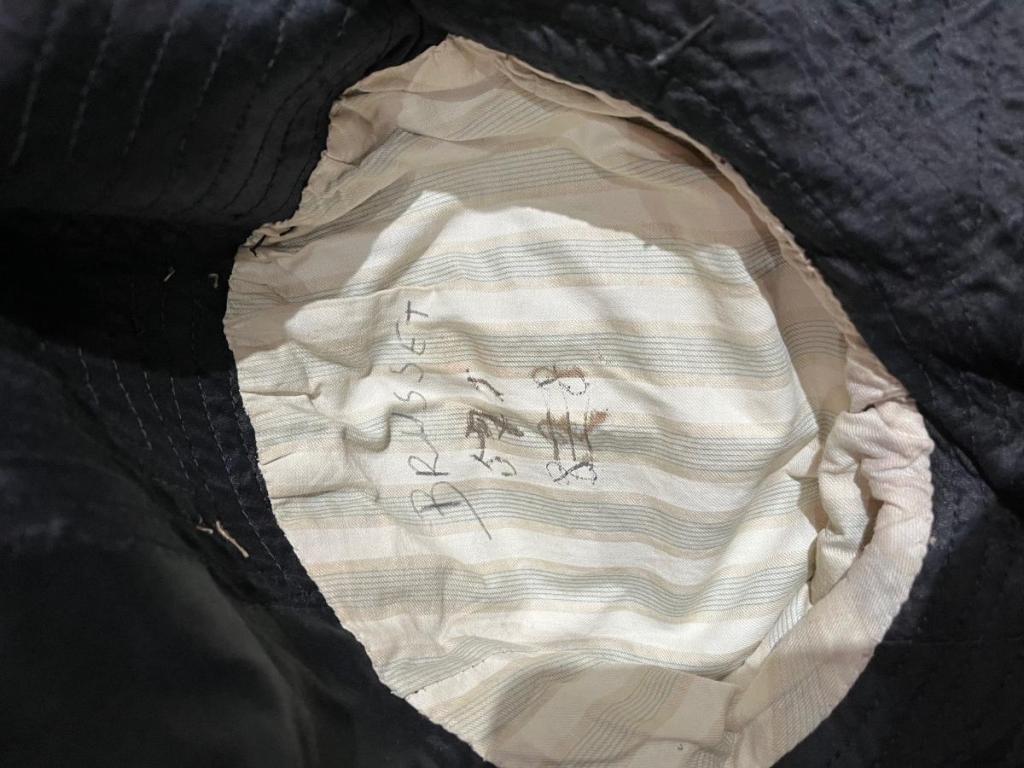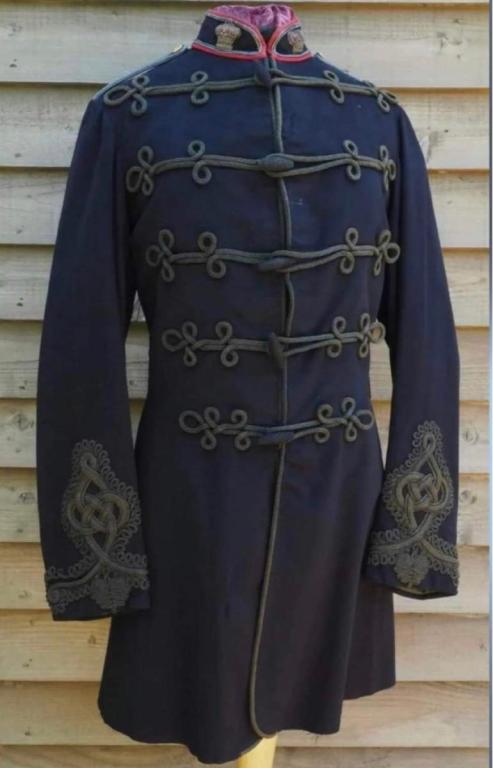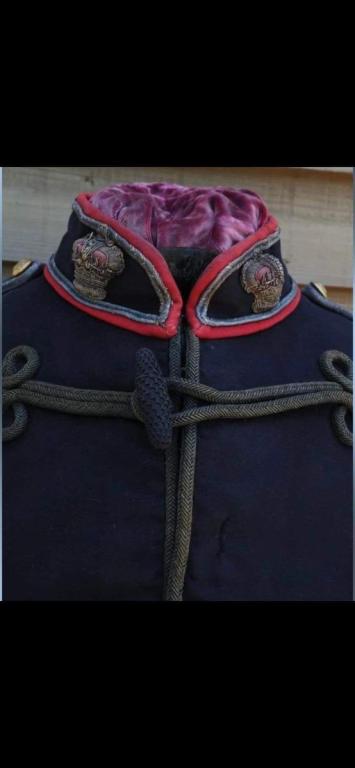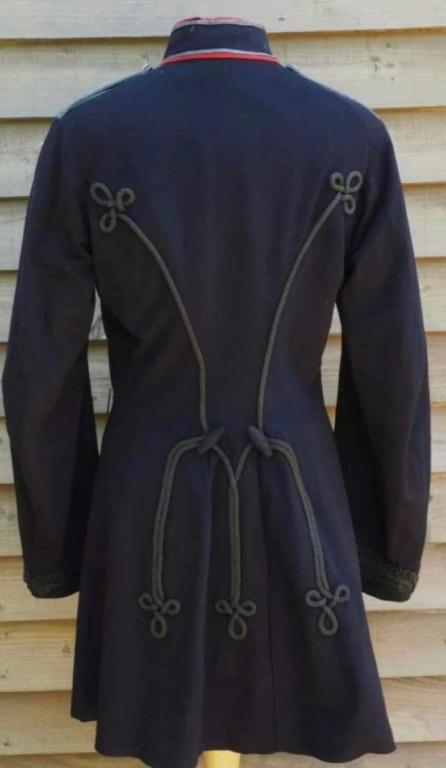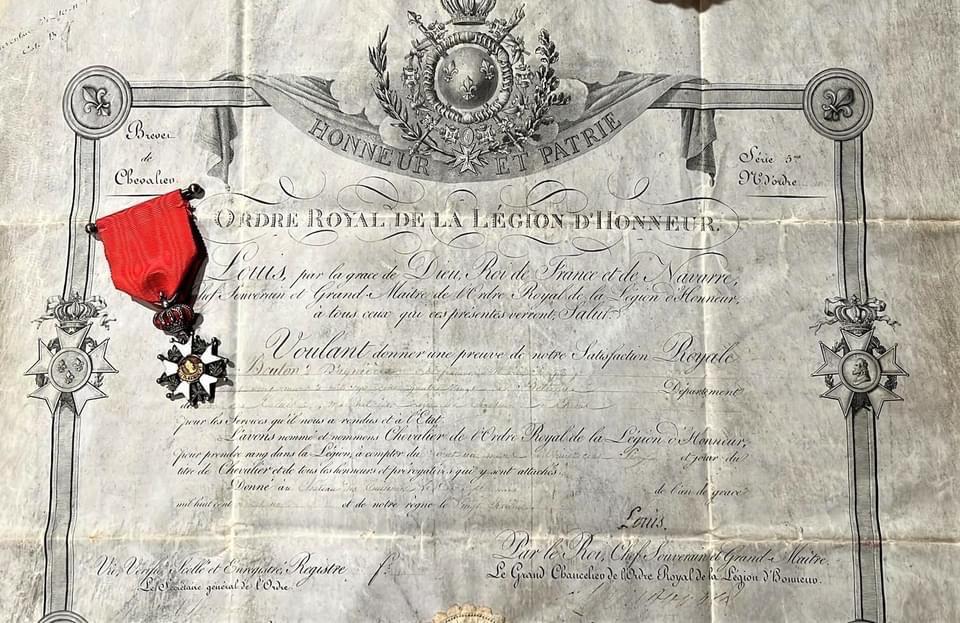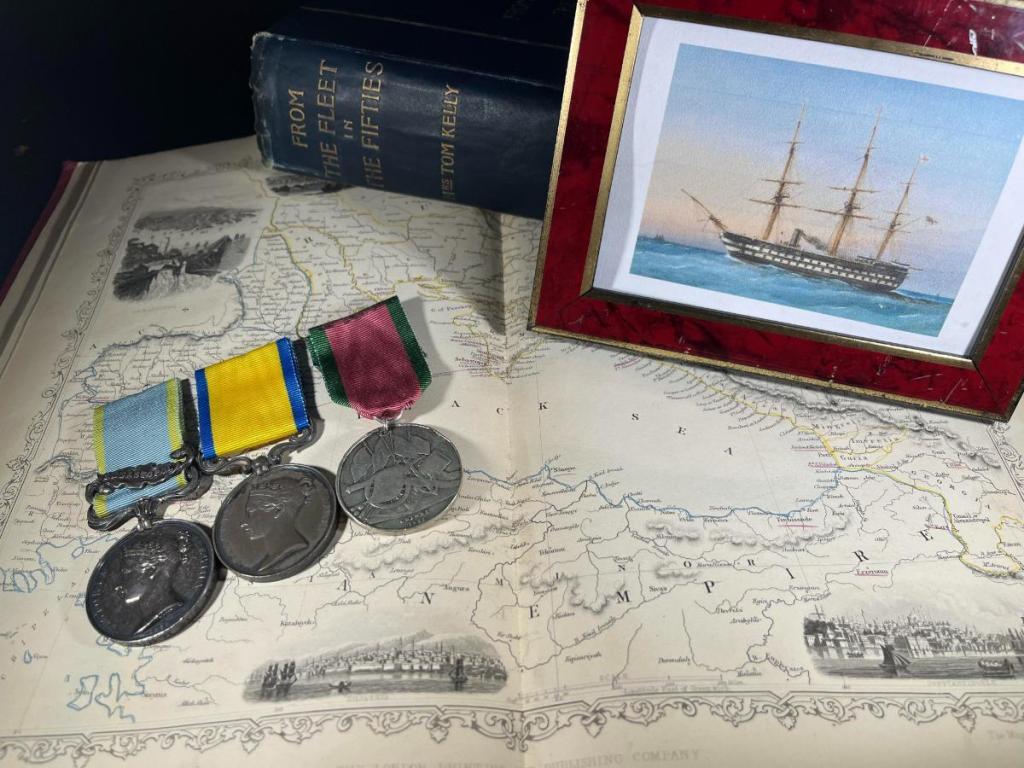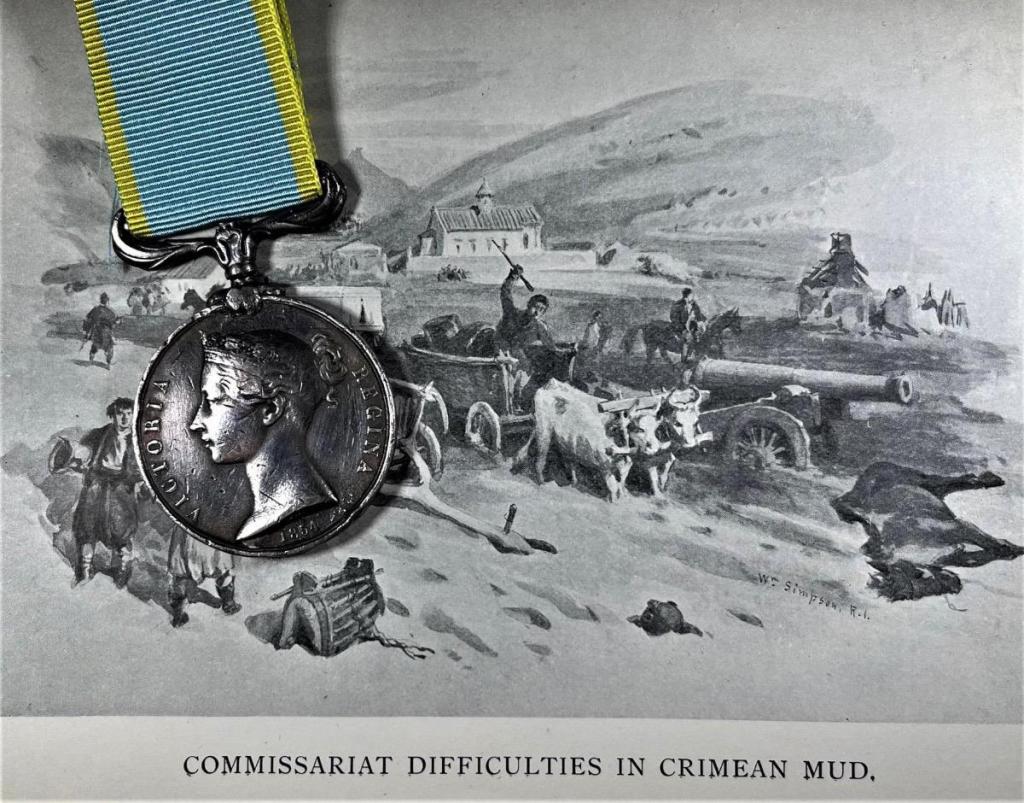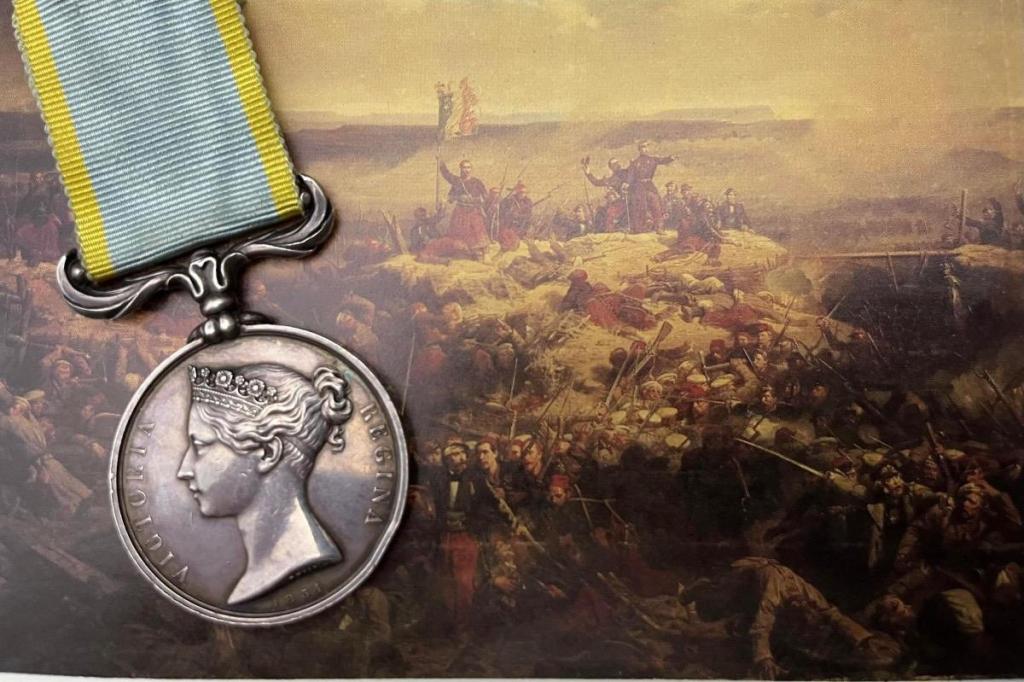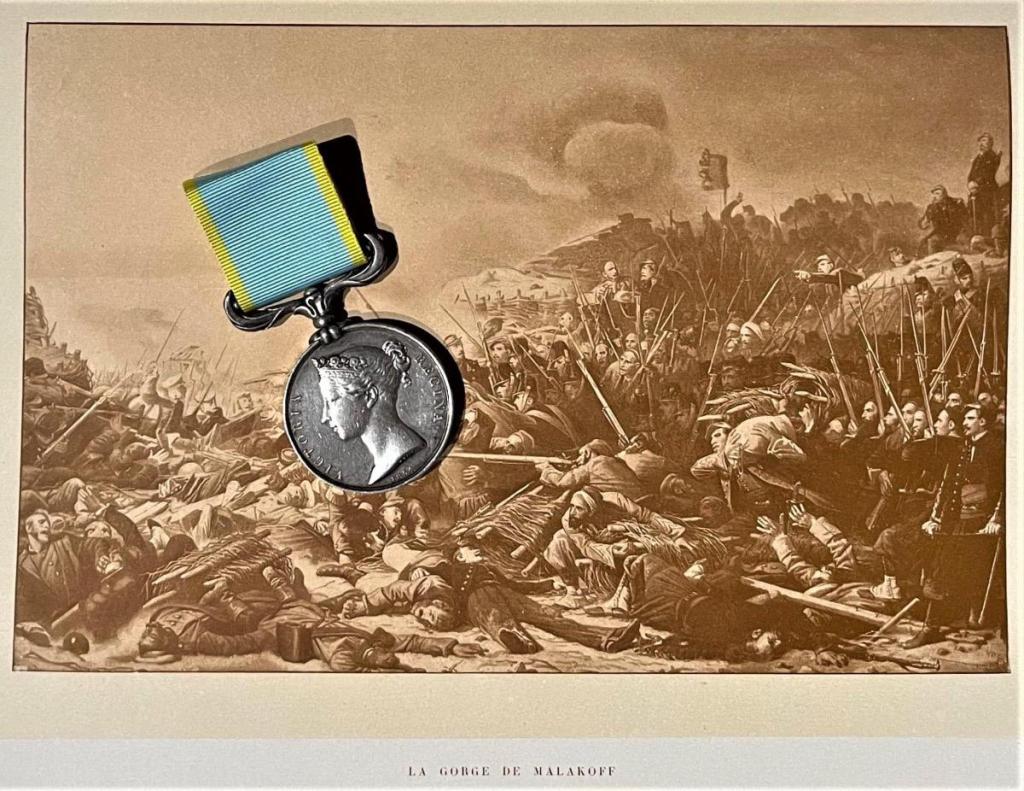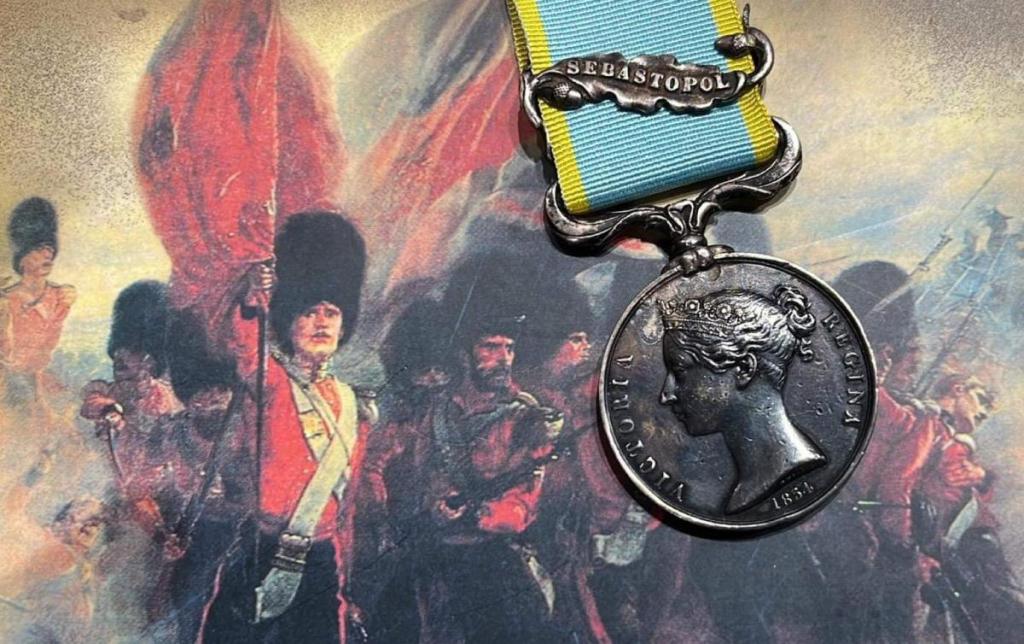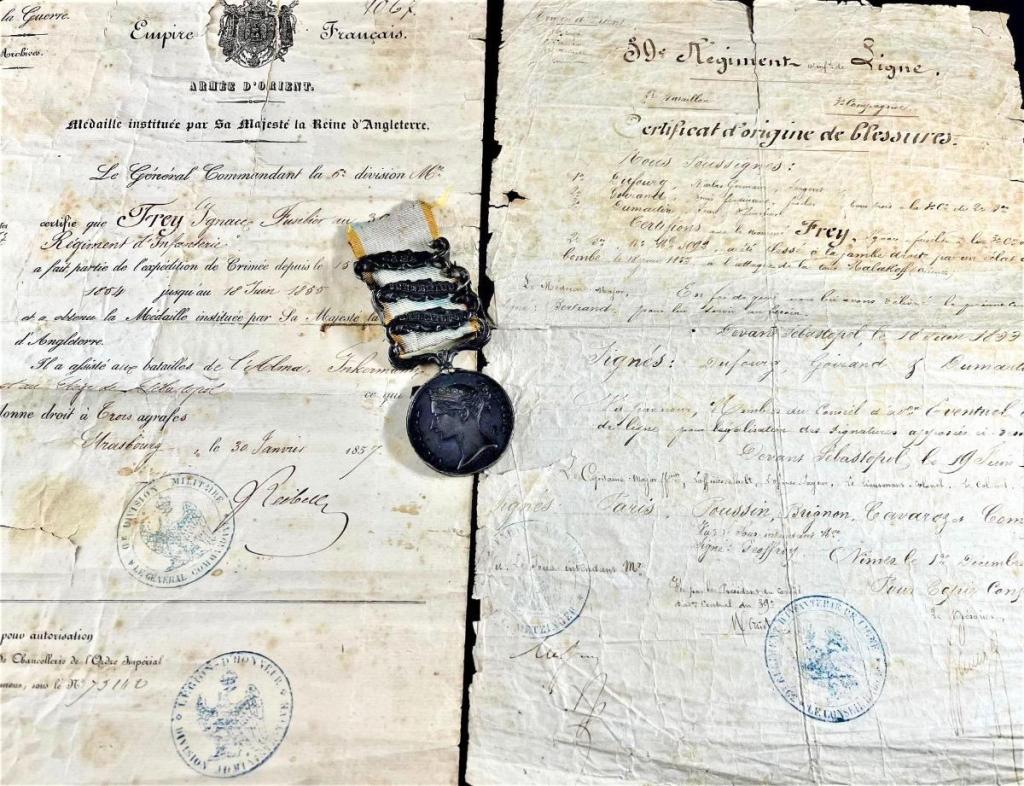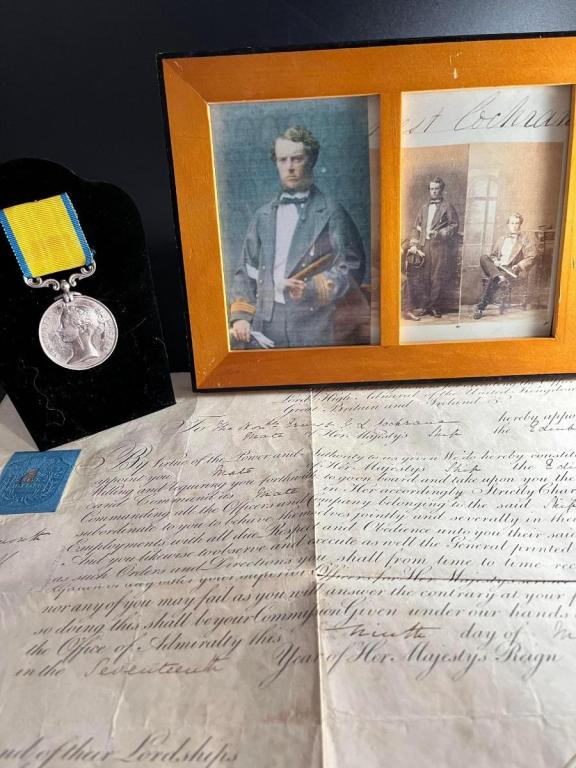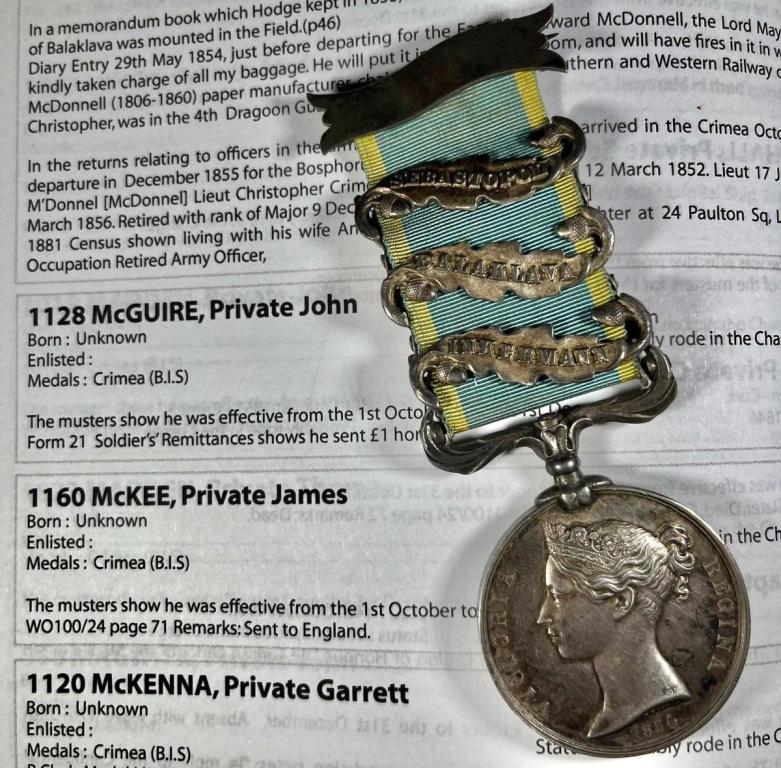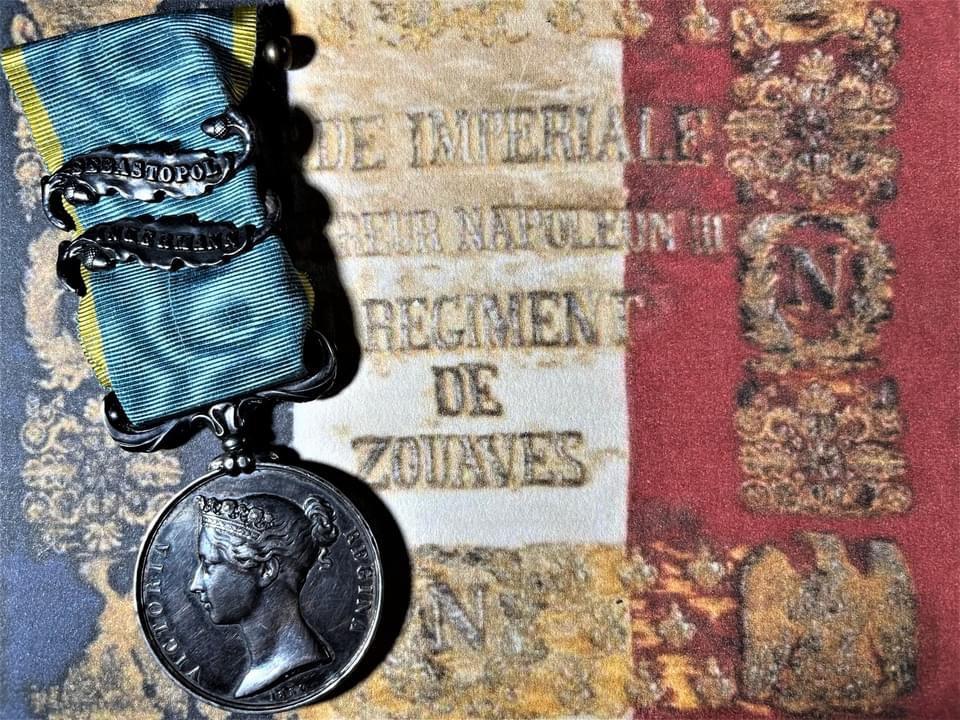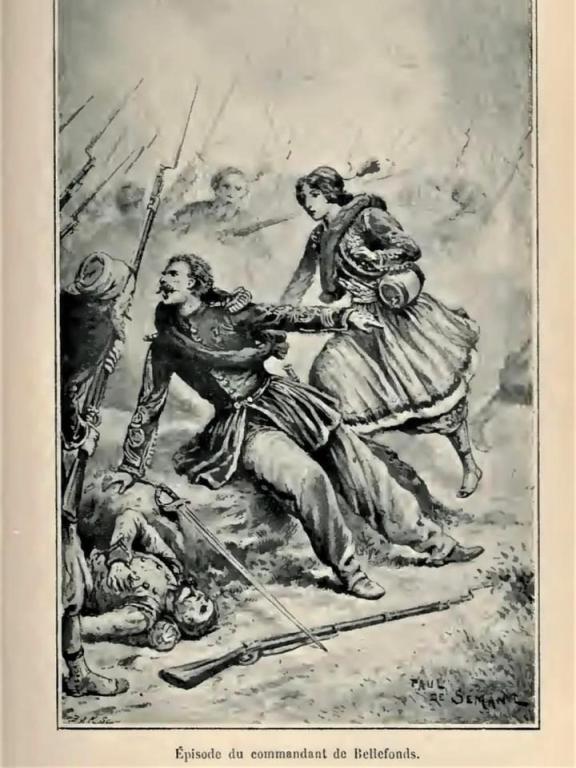-
Posts
2,470 -
Joined
-
Last visited
-
Days Won
2
Content Type
Profiles
Forums
Blogs
Gallery
Events
Store
Everything posted by dante
-
-
While I understand this is most likely a anniversary reenactment piece , any idea what regiment it represents? thanks for looking
-

Unable to identify this uniform
dante replied to dante's topic in Great Britain: Militaria: Badges, Uniforms & Equipment
Thanks Tony, awesome research, the epaulette buttons are Artillery in gold, which doesn't add up....some people have identified as volunteer artillery, but if it was then surely silver buttons? What other pictures are you wanting, happy to oblige -
Crimea clasp Sebastopol, Engraved to “Major J.E. McKenzie” no unit, no one of that name and initials is in the Army list or Ancestry CRIMEA medal roll…have searched all online resources….welcome any assistance finding Major McKenzie ( while appreciating that he may not be entitled (maybe Turkish contingent) he must have at least existed?
-
Légion d'Honneur diplome and medals ; to Capitaine Pierre-Francois Herr Born 29 November 1819 Dole commune in the Jura department. Enlisted age 18 in 1837 aged 18. Served in the 40eme Regiment Infanterie de Ligne served in the 1852 expedition to Rome (Order of Saint Gregory). Noted in 1854 (aged 35) as being involved in 13 campaigns and 17 years service. Transferred to the Le 3e régiment de grenadiers Garde Imperiale est créé par décret du 20/12/1855 did not serve in the Crimea. Later served in the expedition in Italy (battle of Magenta en juin 1859) Second Italian War of Independence. Married 13 January 1864 (Wednesday), Orléans (45), to Céline GUILTEAU and Herr is noted as principal de chemin du fer mediterranean. Died 13 March 1879 Loir-et-Cher. Awarded médaille de la valeur militaire de Sardaigne 30 April 1860 Awarded Chevalier L'ordre de Saint-Grégoire Pontificaux, 20 November 1854 Awarded Chevalier La Legion d’Honneur 14 March 1857 Awarded French Italian War medal
-
Diplome and medals of Capitaine Ignace Kobus, born 15th April 1818, Rouffach a commune in the Haut-Rhin department in Grand Est in north-eastern France. Enlisted as a soldier in 1837 in the 44e Regiment de Ligne, promoted S and transferred Sergeant in 1841 and transferred to the 4e Battalion Chasseurs de Pied, promoted to Sergeant Major/Adjutant Sous Officer 1846 and then transferred to the 2e Battalion as a Sous Lieutenant in in 1848, The following year (1849), he was part of the Mediterranean expeditionary force sent to fight the Roman Republic and took part in the siege of Rome (Médaille du Siège de Rome)/ 1851, he embarked to Africa (Constantine) to participate in the conquest of Algeria. From May 1851, in May 1852 and from July1852 to November 1852, he took part in punitive expeditions against the Kabyle rebels. Promoted to Lieutenant in 1852 he remained with the Battalion until 1855 and in 1855 he was promoted to Capitaine with the tirailleurs 2e Regiment Legion Étranger based in Algeria and in 1856 joined the 1er Régiment Étranger. In 1857 he joined the 11e Battalion Chasseurs de Pied, he was awarded the Légion d'honneur in 1858 finally leaving Algeria in 1859. Took part in the Italian campaign In 1859, the passage of Ticino, at Magenta and at Solferino, where the regiments resisted the three charges of the Austrian cavalry. He married in 1860 He died on June 24, 1865, after contracting a fever while at camp.
- 1 reply
-
1
-
Diplome to Capitaine Pierre-Eloi Francois Marie Joseph BOUTON D'AGNIERES Chevalier de l'empire Français Légion d’honneur Pierre-Eloi Francois Marie Joseph BOUTON D'AGNIERES born 29th March 1780, Pas-de-Calais, Béthune, and belonged to an old noble family, most likely enlisted into the 13eme Regiment des Chasseurs a Cheval formed on the 5 March 1793 on the 20th of November 1796 (aged 16) later renamed 14eme Regiment des Chasseurs a Cheval d’Arras. The regiment had previously taken part in the War in the Vendée (1793) and Army of the North (1794). In November 1796 when Pierre-Eloi enlisted the regiment was part of the Armée des côtes de Brest, with its role to defend France from invasion (a good enough reason to enlist) In 1799 the regiment redeployed to Armée d'Italie a field army of the French Army stationed on the Italian border. Napoleon had taken command in 1796 and had purged the Armée d’Italie of royalists and improved pay and resupply. The regiment was deployed almost immediately and Pierre-Eloi and his regiment under Chef-de-brigade Jacques Boudet was engaged at the battle of Fossano an engagement between a Habsburg Austrian army commanded by Michael von Melas and a Republican French army under Jean Étienne Championnet. Pierre-Eloi was wounded by a sabre blow to the head during the battle and was awarded the sabre d’honneur In 1800 his regiment took part in the Battle of Montebello, in which the French defeated an Austrian army (9 June 1800) during this battle his left leg was shattered by shrapnel, and he was sent to the village of Bormida, in north-western Italy to recuperate. On the 2 November 1805 Maréchal des Logis Pierre-Eloi Francois Marie Joseph Bouton d’Agniers was awarded the Légion d’honneur by Napoleon (Nomination confirmed, Décret 17 March 1821). He returned home to Bethune in 1906 and refused a military pension as his family was wealthy He married Mélanie Aimée Joseph DUPUICH in 1807 (Children Mélanie 1808, Alfred 1820 and Constant Eloi 1815). In 1807 he enlisted as Adjudant Major de la Garde Nationale d'élite du Pas de Calais, as a Captain-Adjutant-Major he takes part in the Escault campaigns 1809-10, Captain of the urban cohort of Béthune 28-1-1814 (Napoleon abdicates April 1814). On Napoleons escape from Elba and on his orders, he musters 100 Royal volunteers and leaves for Lille on 25-3-1815 to defend the King but stops at La Bassée because the king has left. In 1817 appointed by the king member of the municipal council of Bethune. Captain of the Grenadier Company of the National Guard of Béthune in 1833 in command of 130 men and 120 gunners de Béthune Commander of the detachment of volunteers who went to the aid of Paris from 23 to 26-6-1848, during the French Revolution of 1848 (also known as the February Revolution) that ended the July Monarchy and established the French Second Republic. He returned home to his business as a merchant brewer, Eloi died at home in 1854 His son Constant Eloi was born in 1815 and became a Medicin Major with the 125e régiment d'infanterie and was awarded the Légion d’honneur in 1869 and served in the Crimea, China, and Italy, in Algeria 1840 distinguished himself with a squadron of hussars at the massacre of Sidi Brahim he took part in the Franco-Prussian war and was in charge the ambulance of the Church of St Elisabeth in Paris during the Paris Commune.
-
Baltic medal, Crimea medal clasp Sebastopol and Turkish medal to William Cushway, born 25 Dec 1833 from Bethnal Green, London. Enlisted 5th June 1954 for 10 years as an Ordinary Seaman, HMS Waterloo, Commanded (until paying off at Sheerness) by Captain Frederick Herbert Kerr. Joined HMS Hannibal and invalided in 1856. HMS Hannibal was originally planned as a 90-gun second rate ship of the line, to be built at Woolwich Dockyard. She was ordered on 14 May 1840, but cancelled and re-ordered. This ship was also named HMS Hannibal and used the new screw propulsion technology. She was a 91-gun second rate, built at Deptford Dockyard by Charles Willcox, Master Shipwright, and launched on 31 January 1854. She served in the Crimean War, commanded by John Charles Dalrymple Hay. He was a coach builder by trade. He died in 1897 at the age of 64.
-
1
-
Deputy Commissary-general (Colonel) Ashley Cowper Ryland Crimea Medal (missing clasp Sebastopol) Ashley Cowper Ryland was born in Peckham in 1835 and enlisted in the Army on the 1st September 1855 with the Commissariat and Transport Staff and served in the Crimea, including the siege and fall of Sebastopol (Medal with Clasp, and Turkish Medal). the Commissariat and Transport Staff was in-charge of the Provision of food, forage and fuel for the army it infamously struggled to deal with the complexities of supplying the Army during Crimean War; in December 1854 control of the military functions of the Commissariat were transferred to the War Office. The Commissariat remained a uniformed civilian service until 1869 and those still serving were given military ranks. After the Crimea, Colonel Ryland served in Australia and Tasmania, where the Commissariat Department had responsibility for the provisions of military forces, the few remaining convicts, and lunatics. He married Jessy Louisa Ewing in 1860 and in 1870 was posted to Ceylon until the 1880s when was then sent to Egypt until he Retired 1888. Returning to the UK he Died in 1913 in Upper Norwood, South London
-
4040 Private Lot Gorman, 7th Royal Fusiliers, Crimea medal, depot impressed (The medal was found in the USA with the clasp and suspension missing, repaired with original parts) 4040 Private Lot Gorman, enlisted in 13th February 1855 and was embodied on the 1ST May and was sent to Malta on the 4th May and entered the Crimea on the 2nd July 1855. On the 8th September 1955 the final British assault on the Redan, it was a bloody failure hundreds fell cut to pieces by grape and cannister, losses were huge. However the French Guard Imperial assault on the Malakoff was a success and the fort and Sebastopol fell. It was during this assault that Lot was seriously wounded, he was carried off the battlefield and put on board a ship for the 299-mile voyage from Sebastopol to the hospital at Scutari. The records show he made it the hospital but succumbed to his wounds. We have no information on who Lot was, where he came from or if anyone at the time missed him.
- 1 reply
-
1
-
Crimea medal, Named “BINET” “3ART” and the Matricule number “4633” Soldat Binet served with the 3ème Régiment d’artillerie in the Crimea from 1854 and 1855, including the siege of Sevastopol. In 1859, the regiment took part in the victory alongside the Franco-Piedmontese troops at Solferino during the Italian campaign (unable to confirm Binet served in Italy). Sadly, as yet I have not been able to get access to his file held at Service Historique de la Défence but I have his file number (GR 36 YC 104) which will show his medals, clasps and Battery. When time came to distribute the Crimea Medals, 3ème Régiment d’artillerie was issued a total 1405 medals. In 1855 At the time of compiling the regimental medal list, 1099 Soldiers had received the Medals – with still pending 306 to be delivered. They were collectively entitled to: 1405 Sebastopol Clasps, 79 Alma clasps, 5 Balaklava clasps and 5 Inkermann clasps. So we are 100% sure that Binet got the Clasp "Sebastopol" Clasp. Will update as soon as more information is available.
-
Single named Crimea medal (entitled to Sebastopol clasp) to Frenchman Jacques Henri Lecompt, 2e Voltigeurs de la Garde, born 13th April 1829 in Saint-Calais a commune in the Sarthe department in the region of Pays de la Loire in north-western France. He originally enlisted in 1850 and transferred to the 2e Voltigeurs de la Garde in 1854, sent to the Crimea He was wounded (left arm) by shrapnel in the trenches during the siege of Sebastopol in the night from 21std to 22nd August 1855. 31st Discharged in 1856 and received a certificate of good conduct. The 2nd Regiment of Voltigeurs of the Guard was created in 1854. One of its battalions was sent to Crimea and landed there on 28/1/1855, the entire regiment joined it in May and distinguished itself during the capture of the works of May 22, 1855, by losing 14 officers and 300 men.
-
This has been a challenge, mainly because his name which changes from Bladen and Bladon. Crimea medal clasp Sebastopol, named to 6013 Private John Bladen (or Bladon), originally from Ashbourne, Derby enlisted into the 1st Battalion Grenadier Guards aged 24 in 1850. 3rd Battalion formed part of Lord Raglan's Army, which had previously stormed the heights above the River Alma and besieged the Russian fortress of Sebastopol. Entitled to the Turkish war medal In 1861 John Bladen joined the Manchester police and is noted in several newspaper articles and court circulars for arrests. In 1871, we find him promoted to Police Sergeant and his death is noted in 1874 aged 45, he is buried in Manchester general cemetery. I am sure there is a story here but to date it has alluded me.
-
1
-
George Titmuss (AKA Titmus) Depot named Crimea war medal clasp Sebastopol and named “La Crimee” Turkish war medal. George was born in 1832 • Pirton, Hertfordshire, England. He was baptized on March 25, 1832 in St Mary the Virgin Pirton. His father died in 1844, he left school and worked as a straw plaiter and labourer employed at Wellbury Farm, Offley by a farmer Thomas Smoothy and in 1853 he was caught stealing and received 6 months in prison on release he enlisted into the Royal Regiment of Artillery. In 1854 he deployed to the Crimea to take part in the siege of Sebastopol with Number 7 Company 6th Battalion Royal Artillery under Captain John Boothby (Later Major General & First class cricketer), George served 6 months in the Crimea was wounded/injured following an explosion of a Magazine in the trenches surrounding Sebastopol (most likely at French Park on the 15th November 1855), he remained in the army and married in 1862 to Harriet Carew PETERS at the citadel barracks Plymouth, went on to serve on Alderney in the Channel Islands then five years in Gibraltar and one year in Agra India (most likely with 7 Battery 22 Brigade RFA). I was here his wife Harriet and youngest baby Alice died and were buried in 1871. Having served 17 years, he was pensioned due to disability aged 40 as a danger to himself and others undertaking gun drill due to age and injuries in the Crimea. He appears to have gone of the rails on leaving the army, fighting, larceny, common assault, resulting in periods of prison and hard labour He remarried in 1874 to Eliza HARMER and they lived at St. Ippollitts, Hertfordshire, England. In 1901 aged 70 he is noted as an Army pensioner living in Ardeley, Eliza his wife died in 1911 and George died in 1912 aged 80. He received a military funeral which was held at Hitchen and noted in the local paper as a veteran of the Crimean war. Note…George was an undoubted rogue who lived a long and hard life, his medals have for over 150 years stayed together and certainly worn by George most likely on his coat long into his retirement and I dare say down the pub to regal the locals and to get his beer bought for him.
- 1 reply
-
1
-
British Crimea medal to French soldier Fusilier Ignace Frey who served in the 39eme regiment d Infanterie de ligne, 2eme Bataillon, 3er compagnie, Ignace came from Ebersheim, Bas Rhin, Alsace and was wounded three times on the 18th June 1855 “Battle of the Great Redan” during the ill-fated attack on the Malakoff redoubt in which the French attacked an hour before the both their forces and the British had reached the start line, they were slaughtered in the wide open. He was awarded the clasps Alma, Inkermann and Sébastopol Have been unable to find out what happened to Ignace after the war
-
Rare confirmed heavy brigade charger Crimea medal group, to 944 Sergeant John Kidney 6th (Inniskilling) Dragoons, wounded in the charge, 25th October 1854.John Kidney was born in 1827 and prior to joining the British Army he had been a farmer from, Magracross, Drumcolhan, Co.Fermanagh, Ireland. He enlisted into the 6th Dragoons on 29th August 1846 aged 19 and served with the 6th throughout the Crimean War. On March 1858 he is seen re-enlisting as No.65 L/Cpl JOHN KIDNEY, 5th Lancers with whom he served until he was discharge at his own request aged 43 on 20th January 1870. He had served in the two units for a total of 25 years & 324 days. (Final discharge papers, Canterbury, 9th to the 23rd July 1872)In 1869 he was 'busted' down to Private for an unknown misdemenor. His previous conduct was shown as "Very Good" and he was in possession of 5 good conduct stripes. However,he appears in the regimental defaulters book on two occasions and is shown as being twice court marshalled. (Hence no L.S.G.C. medal)
- 1 reply
-
2
-
Named Baltic medal (with interesting replacement suspender) commission document to Captain the Honorable Ernest Grey Lambton Cochrane Royal Navy, Born to Thomas Cochrane, 10th Earl of Dundonald, and Katherine Corbett Frances Cochrane on the 4 June 1834, his father was a British naval flag officer of the Royal Navy, mercenary, and Radical politician. He was a successful captain of the Napoleonic Wars, leading Napoleon to nickname him le Loup des Mer’s, 'the Sea Wolf'. In 1847 he entered Royal Navy and served on board the ships Victory, Hibernian, and Trafalgar In 1854 Participated in the Battle of Bomarsund, in August 1854, which took place during the Åland War, (part of the Crimean War) as part of the Anglo-French expeditionary force attacked a Russian fortress. It was the only major action of the war to take place at Bomarsund in the Baltic Sea. He was part of the initial land reconnaissance of the fort and his reports enabled him to be appointed Aide de Camp to Brigadier General Jones, the fort was captured and Cochrane was part of the surrender delegation, he was later mentioned in dispatches. Aug. 29, 1854, made lieutenant of the Edinburgh and in 1856 Served as lieutenant-commander of HMS Chub, West Africa Station Freetown, Sierra Leone In September 1864 he married Adelaide Blackwall, daughter of Samuel W. Blackwall, Governor of Sierra Leone, she died a month later In October 1866 he married Elizabeth Frances Maria Katherine Doherty, only child of Richard Doherty of Redcastle Between 1868 to 1870 he was Commander of HMS Petrel off the Cape of Good Hope and West coast of Africa Participated in the suppression of the slave trade In 1873 he retired as Captain RN He was appointed in 1879 High Sheriff of County Donegal He died at his Redcastle estate, Inishowen, County Donegal, Ireland on February 1911
-
The fighting Irishman; Recent purchase from an online jewelry store in the USA. As many will be aware for collectors the Crimea medal is fraught with difficulties, issued unnamed the naming found was for the most part privately undertaken, some engraving has been attributed, but most have not, those medals most at risk from forgery have been light brigade chargers, the thin red line and those whose lives are well documented. Johns Crimea medal has been engraved by a yet known engraver and at some point, the clasps have been removed and put on in the wrong order. Roy Dutton whose monumental work on those who took part in the Charge of the Heavy Brigade published in 2008, confirms that 1128 Private John McGuire, 4th Royal Irish Dragoon Guards took part in the Charge, no other details were available. Having purchased the medal for the cost of an unnamed no clasp medal I set about trying to find John McGuire. For two days I went through every John McGuire on “Findmypast” on the second day under the 4th Hussars I found him Born in Roscrea, county Tipperary (he was noted as being a Clerk). Enlisted into the 4th Royal Irish Dragoon Guards from 20th June 1852 (aged 18) to the 31st December 1856 (regimental number 1128). Served in the Crimea, Charge of the Heavy Brigade, Crimea medal clasps Balaclava, Inkerman, and Sebastopol. Transferred to the 2nd Dragoon Guards (Queen's Bays) 1st January 1857 (regimental number 76). Served in the Indian Mutiny Medal 1857-59, Clasp: Lucknow took part in the charge at Nusrutpore Private on transfer, 1857 Corporal, 1862 Sergeant 1863 Re-engaged, 1863 Troop Sergeant Major, 1866 Court Martial Drunk, 1869 Reduced to Private Transferred to the 4th (Queen's Own) Hussars, 1st July 1869 to 24th October 1871 (regimental number 1143). (then stationed in India) Private 1869 Corporal 1870 Sergeant 1870 Court martial, Drunk, reduced to private He applied to the General officer commanding India 21st May 1872 to be discharged aged 37 and 6 months on pension with place of residence noted as Melbourne Australia. Is this Johns medal, to be 100% is almost impossible, but for me its his and while much of his life is still a mystery, taking part in two or more cavalry charges makes him a hero, who is not forgotten. Now to find his Indian Mutiny medal
-
1
-
Baltic medal “H Achilles” “HMS James Watt” Henry Achilles, born Heinrich Friedrich Christoph Achilles was born 7th May 1831, Housling, Erlangen, Bavaria, Germany, (though some archives have him from Braunschweig). Little is known of his early life but on the 18th of November 1845 he and 14 other musicians arrived in Hull from Hamburg abord the steamer “Queen of Scotland”. In 1852 we see him join the Royal Navy as a Bandsman aboard HMS James Watt a 91-gun steam and sail-powered second-rate ship of the line. launched on 23 April 1853 and commissioned at Plymouth in January 1854 by Captain George Elliot. The roll of the Bandsman was in times of battle assigned to magazine and handing room crews as well as Ammunition supply. They may have had additional tasks when mooring and unmooring ship, They were classed as "Idlers" which means they had no station aloft and were not part of a gun's crew. They also had no specific, very important job like Cook, Sailmaker, Carpenter's Crew etc. These latter were classed as "Working Idlers", they also played for the Captain and kept the ship's company in live music here and there. HMS James Watt served in the Baltic campaigns of 1854 and 1855 including In August 1855 Cronstadt, the Russian Baltic naval base; the minor long-range Crimean War engagement near the Tolbukhin lighthouse with the port's batteries and gunboats on 16 August 1855. In 1857 he left the Navy with his character noted as “very good” on discharge he moved to Devon then to Highbridge, Somerset. In 1859 he married Selina and started works at the Somerset & Dorset Joint Railway, Highbridge railway works as a painter. He retired after 37 years (his wife died some years earlier) and died in 1913 aged 82 and he is interned in St John's Church, Highbridge, Somerset.
-
1
-
Crimea medal named; Pietro-Giuseppe (later Pierre-Joseph) Rossini was born on February 15, 1824, in Isolaccio di Fiumorbo a small commune of a few hundred people, in Haute -Corsica, he was the son of Ferrando Rossini and Maria-Nunzia Micaelli. Isolaccio was a modest village nestled on a hill over 1,800m above sea level, in the wildest part of the island, according to some observers who passed there ... In 1808 nine of its inhabitants were shot by the troops of Napoleon and many were the deported. His first job was as an office boy, he is noted as being sentenced to 15 days in prison for wilful injury. This prompted him to enlist in the French army and on June 27, 1842, he joined, the 8e régiment d'infanterie de ligne based in Bastia, under the orders of the colonel Vincent Garrido. Four years later, he left Corsica for Africa. On March 1, 1846, he joined the 22e régiment d'infanterie de ligne which was stationed in Constantine, Algeria. He first served there as a simple voltigeur then he rose through the ranks: corporal on May 28, 1848, and sergeant on June 20, 1850. On March 5, 1852, he was assigned, to Blidah, to serve with the 1st Zouave Regiment, an elite-regiment. He only stayed there for a year, then he was transferred on August 6, 1853, to Oran, to the 2nd Zouave Regiment which had just been formed from elements of the the 1st; 3800 strong, it was led by Colonel Cler, future general. The unit's focus was on road work between Oran garrison and Tlemcen garrison. After this 9-year long campaign "under the scorching sun of Algeria" (Zouaves' march song) Rossini left Algeria to return to France (most likely with elements of the 3rd Zouaves) but on his arrival is mobilised to the Crimea. On March 26, 1854, he joined the prestigious Zouave regiment of the Imperial Guard, created at the start of the year. (décrets des 23 décembre 1854). “On 23 December 1854 a fourth regiment was created, the Zouaves of the Imperial Guard. The actual formation of this unit was delayed until 15 March 1855 when detachments from the zouave regiments already serving in the Crimea were brought together before Sebastopol for this purpose. Having earned the unusual distinction of being created on the field of battle, the Zouaves of the Imperial Guard served through the remainder of the Crimean War” (There is note of him being entrusted with the regimental colours during the campaign) On his return he was housed in Satory barracks, commune of Versailles, and was decorated with the Medaille de Crimée est une médaille commémorative Britannique (Crimea medal). On May the 9th Sergeant Rossini was injured while on duty, he was going to fight a fire in the Saint-Martin barracks in Versailles: he fractured his left radius while falling. It was most likely during his convalescence he met Jeanne-Marie Barbée (AKA Barbé or Barbe) the daughter of a local carpenter. The relationship with Jeanne-Marie is somewhat confusing as we know that Jenny was born on July 1858 and they married on June 17, 1859, noted in the decree published in the Official Gazette. But at some stage Jeanne-Marie had become a regimental Cantinière (Vivandière or cantinière is a French name for women attached to military regiments as sutlers or canteen keepers). The regiment was mobilised in 1859 in support of Victor-Emmanuel of Savoy and both Pierre and Jeanne-Marie both went to war. While little is known about Pierres war Jeanne-Marie’s is well documented Jeanne-Marie was wounded on May 31 during the Battle of Palestro, which defeated the Austrians and further distinguished herself again on June 4 by saving the life of the Colonel, during the decisive battle of Magenta, which saw about 120,000 men clash, leaving 2,095 dead, 7,403 wounded, and 5,235 prisoners and missing. On June 17, 1859, by decree published in the Official Gazette (which names Barbe by her married name Rossini) she was awarded the Commemorative Medal of the Italian Campaign and Medaille Militaire (Military Medal) for gallantry the first women to be awarded the decoration. The 25-year-old like the other holders of the Military Medal, received a life annuity of one hundred francs. In October 1862 Jeanne-Marie gave birth to another girl while based in the Louvre district, garrison of the Zouave regiment of the Guard, where the couple resided. In 1863 Sergeant Rossini re-engages and is transferred Oran in Algeria, as a private 2nd class in the 2nd Zouave regiment commanded by Colonel Lefèvre (a future Versaillais who will lay siege against the Paris Commune). (re-engagement in another unit meant he had to start from zero). On December 24, 1863, he was promoted to private 1st class, the following March 30 1864, corporal; and in the following December 1865, he further re-enlists for 2 years. He is promoted back to the rank of sergeant on January 8, 1868: and in March 6, 1868, he retires after 25 years 1 month and 24 days of service which, cumulated over 12 years 2 months and 5 campaign days (included in these 25 years) which counts as double, this gave him a total of 49 years of service. 11 months 18 days. His pension was 565 francs. Despite his seniority, he had only been a sergeant for 3 years 5 months and 26 days and in December 31, 1868 his file was closed. His pension was effective from January 1, 1869. Pierre returned from Oran in July 1869 and settled in Paris. He was only 45 years old. We do not know what he did for work but on the outbreak of the Franco-Prussian war in 1870 he joins the National Guard (Garde Nationale) and is promoted Captain in the First battalion of the Avengers of Paris, a free corps of 30 officers and 497 men, we also know that Pierre-Joseph in 1871, made a radical choice by rallying to the Paris Commune. We do not know what his responsibilities or missions were... In any case, it seems that when the Commune was crushed, he managed to escape summary execution the fate of many of his compatriots. (Between 6,000 and 7,000 Communards are confirmed to have been killed in battle or executed) He and his family evaded capture until December 1874 when he was arrested and appeared before the 3rd Council of War (set up to repress the Commune). He was sentenced to deportation to New Caledonia (and the loss of the Medal of 'Italy), in a fortified enclosure on the Ducos peninsula. In 1879, Rossini he received a pardon by the President of the Republic and on June 3, he embarked with 405 deportees or convicts on the Navarin which anchored in Brest on September 28. We do not know if he ever saw his wife and children again, we do know that on May 12, 1884, the death of Jeanne-Marie Barbé (sic) in Montrouge of 11 avenue de la Paix, in the department of Seine was announced. She was 50 years old and had no profession. We also do have note that in her death notice that Pierre-Joseph Rossini, retired, was known to be homeless, (according to Augustin-Paul Dolter, 40, an employee of the Seine prefecture). No note of what happened to Pierre-Joseph Rossini nor how his medal survived Sources: Research Guy Lidec Archives de la Grande chancellerie de la Légion d’Honneur. Archives Nationales BB/24/811. Dossier de deman-de de grâce. Archives de la préfecture de police de Paris. Listes de contumaces et amnisties (cote BA 470). Archives du Service historique de la Défense à Vincennes. Dossier de pension de Rossini 4Yf 51104 et dossier de justice militaire 8J 1932. Archives nationales d’Outre-mer à Aix-en-Provence. Archives BMS et NMD de Carhaix, Gourin, Concar-neau, Paris (fichier), Béziers, Montrouge et autrescommunes.


